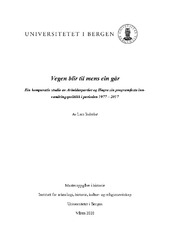Vegen blir til mens ein går: Ein komparativ studie av Arbeidarpartiet og Høgre sin programfesta innvandringspolitikk i perioden 1977 – 2017
Master thesis
Permanent lenke
https://hdl.handle.net/1956/22663Utgivelsesdato
2020-06-17Metadata
Vis full innførselSamlinger
- Master theses [240]
Sammendrag
Abstract This is a comparative study of the Norwegian Labour Party’s (Arbeidarpartiet) and the Norwegian Conservative Party’s (Høgre) immigration and integration policy in the period 1977 – 2017. The primary source of this study are the two parties’ programs from this period. The aim of this study is to find out how the immigration and integration policy in these two parties’ programs have changed and developed in the period 1977 – 2017, as well as differences and similarities between the two parties. This study’s main findings suggest that both parties have developed in a more restrictive direction over the years concerning the immigration policy aimed at asylum seekers and refu-gees. The Norwegian Conservative Party has the overall most restrictive policy of the two, however the similarities are greater than the differences. In the case of migrant workers in the 2000s the ideological differences are at its clearest; both parties have a liberal view on migrant workers from the EU/EEA, but in the case for mi-grant workers from countries outside the EEA, the Conservative Party has a more liberal line. While the Labour Party do not want to drain developing countries of important labor, the Con-cervative Party’s focus is on Norwegian companies need of labor. The Labour Party also has a greater focus on pay and working conditions for the migrant workers. When it comes to the integration policy the Labour Party has developed towards a more restrictive line compared to the Conservative Party in cases concerning cultural and religious expressions and practices. Over the years both political parties have adopted a more comprehen-sive policy in both the immigration and integration area. Their concerns when it comes to inte-gration are mostly the same, with some smaller differences. Both parties want the immigrants to learn the Norwegian language and get a job as fast as possible. They both are concerned regard-ing high unemployment among people with immigrant backgrounds, as well. Since this policy area is relatively new, the two parties’ policy seems to have been developed as new challenges emerged. In other words; their politics seems pragmatic. The overall picture is of two parties with similar development over the years, regarding both the immigration and the integration policy.
